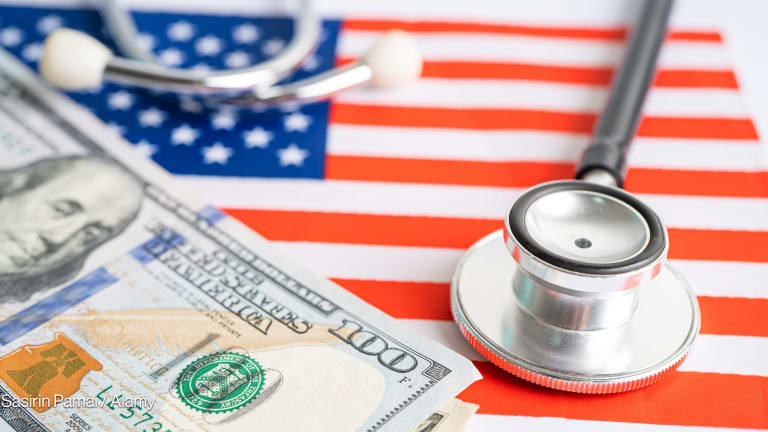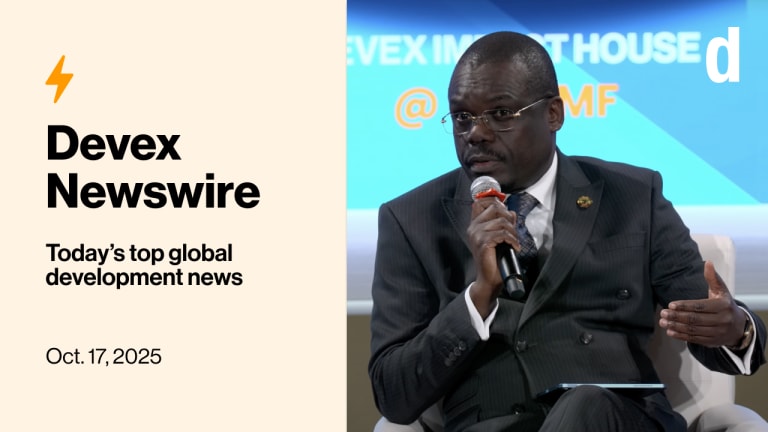
SAN FRANCISCO — Nine 747 jumbo jets filled with personal protective equipment, including surgical masks, gloves, and eye protection, are making their way to 11 African countries as the result of a new collaborative effort to pool resources for PPE for community health workers.
Tuesday marked the launch of the COVID-19 Action Fund for Africa, or CAFA, which brings more than 30 members together in “the largest mobilization of private resources to protect Africa’s frontline health workers from COVID-19.”
They may seem like superheroes, but doctors, nurses, midwives, and community health workers need support too. This content series takes a look at how health systems can function better so that health care workers are supported, protected, and empowered.
Anchored by a $10 million commitment from the medical assistance organization Direct Relief, the fund has begun delivering nearly 60 million pieces of PPE, and it seeks to raise up to $100 million to supply one year’s worth of PPE for 1 million community health workers across 24 African countries.
Since the beginning of the coronavirus outbreak, global demand for PPE has surged while shortages have driven prices up 20 times higher than normal, according to the World Health Organization.
This led to an increase in COVID-19 infections among health workers, and the partners behind CAFA say CHWs in low- and middle-income countries have borne the brunt of the global shortage of PPE.
“We think the distribution of PPE reflects existing biases about the worth of the lifesaving work that CHWs do. PPE should be distributed based on the service provided, not the service provider.”
— Madeleine Ballard, co-founder and executive director, Community Health Impact CoalitionInitially, organizations supporting CHWs worked on an individual basis to procure PPE, but as they continued to see inequity in access, they began to explore how a large-scale partnership could allow them to secure better prices and get supplies where they were needed most.
Estimating the need
Most sub-Saharan African countries have not prioritized CHWs in their PPE allocation, instead ensuring that other health providers got sufficient materials to protect themselves from COVID-19, said Madeleine Ballard, co-founder and executive director of the Community Health Impact Coalition.
“We think the distribution of PPE reflects existing biases about the worth of the lifesaving work that CHWs do,” she said. “PPE should be distributed based on the service provided, not the service provider.”
While technology has helped some health workers to make the transition to low-touch or no-touch protocols, CHWs are essential in responding to the pandemic and ensuring the continuity of other health services, and as they continue to go door to door, they risk putting themselves and others at high risk of COVID-19 infection, Ballard said.
But without reliable estimates of the number of CHWs, let alone their PPE needs, groups that sought to protect CHWs during COVID-19 could not draw on data to make their case.
Ballard was part of an effort to quantify the PPE needs for CHWs in sub-Saharan Africa, which was published by the Center for Global Development.
She and her co-authors estimated 448 million pieces of PPE would be required annually: 213 million surgical masks, 100 million pairs of gloves, 3.7 million face shields or goggles, 1.6 million reusable gowns, and 130 million disposable biohazard bags
These numbers, which were validated by ministries of health and implementing partners, are meant to offer a baseline that governments, partners, and donors can draw on in their supply planning.
The authors, many of whom are directly involved in advocacy for CHWs, emphasize that these are estimates, and do include some caveats about their findings — including the lack of data for current PPE stock on hand or in transit.
“The idea was to move with a good balance of speed and rigor,” Ballard said.

Getting PPE at a discount
Based in Santa Barbara, California, Direct Relief holds N-95 respirator masks in inventory because of the frequent wildfires in the state.
The masks are made in China, so it came as a surprise to Andrew MacCalla, vice president of emergency response, when Wuhan Union Hospital reached out on January 25 asking for help with PPE.
Inside the largest hub for global humanitarian medical aid in the US
Direct Relief completed its new 155,000-square-foot headquarters in California in 2018. Devex visited the facility to find out how the nonprofit approaches disaster response.
Direct Relief sent 850,000 masks that had just arrived from China straight back to the country, before it became clear that this need would spread globally, and the masks Direct Relief once bought for $.40 would spike in price to $4.40.
Soon, 20 countries a day were asking Direct Relief for PPE.
“It’s been very difficult to know how to allocate resources,” MacCalla said.
As the need for PPE became universal, he started to prioritize requests from countries where the consequences of COVID-19 were likely to be the most catastrophic and the PPE supplies were likely to reach the people who needed them most.
After MacCalla saw the CGD paper quantifying the PPE needs of CHWs, and learned how CHIC members could help turn those estimates into orders, he and his team saw the opportunity for partnership.
For them, Direct Relief’s work to deliver PPE in Africa was a natural extension of the $25 million fund the organization launched in April to protect community health providers in the United States.
“The PPE marketplace has been such an absolute nightmare,” MacCalla said.
But by joining together, CAFA members can place large orders, which he said has allowed Direct Relief to get supplies at a major discount.
“With that $10 million, we have made some of the biggest purchases in our history,” MacCalla said.
Direct Relief has bought 25 million surgical masks, 800,000 face shields, and 33 million gloves for the first 11 countries for the first 6 months, and the partners involved in CAFA now seek to raise more funds to continue to meet the need.
Sending the supplies where they need to go
Insufficient PPE pushes NGOs to consider making their own
The Norwegian Refugee Council and IFRC are among the organizations exploring a new avenue to scale up necessary personal protective equipment supplies.
Even before the COVID-19 pandemic arrived in Africa, organizations supporting CHWs were discussing how to preposition PPE supplies, said Tapiwa Mukwashi, senior manager for supply chain at VillageReach, an organization that focuses on improving health systems in low-income countries, and is a member of CHIC and CAFA.
They were concerned not only about the availability and cost of PPE, but also the impacts COVID-19 lockdowns were having on supply chains, with border closures and curfews “disabling the fast flow of highly responsive supplies,” he said.
Before countries are approved for donations from CAFA, they must provide their supply chain capacity and distribution plan to ensure that resources get from the port of entry to the last mile, and VillageReach will work within countries to document arrival and distribution of the equipment, Mukwashi said.
The 24 countries involved in CAFA have different preferences when it comes to the type of PPE they want to provide their frontline health workers.
Members of the fund explained that most countries are requesting masks, gloves, and eye protection, and only some are requesting gowns and coveralls. But none of these countries are used to dealing with such large shipments of medical supplies.
For example, in Uganda, when a plane full of masks arrives, the country will need 40 trucks to pick up the delivery, space to store 800 pallets, and plans to get these supplies to the community level, MacCalla said.
The CGD paper outlines that PPE alone is not enough to protect CHWs. It advises policymakers to consider other interventions, for example to ensure that PPE does not contribute to the stigma some health workers have reported experiencing.
It also notes the need for more domestic and regional manufacturing of PPE, which would offer a more sustainable alternative to the high transport costs involved in CAFA’s efforts to deliver PPE procured from China and Vietnam.
Given the scarcity of PPE, some of these countries may still find they need some of the PPE provided by CAFA for health workers in hospitals and clinics, and prioritize those workers over CHWs.
“I don’t think any of us feel it’s our job to dictate to a government the best use of resources on that level,” Emily Bancroft, president at VillageReach, said.
While CAFA is requesting supplies go to unmet needs for CHWs, the members said they will defer to government and NGO partners to optimize PPE allocation depending on local needs.
Update, Aug. 11,2020: This article has been updated to reflect that Emily Bancroft is the president at VillageReach and Andrew MacCalla is vice president of emergency response at DirectRelief.
Visit the Duty of Care series for more coverage on how health systems can function better so that health care workers are supported and protected. You can join the conversation using the hashtag #DutyOfCare.







